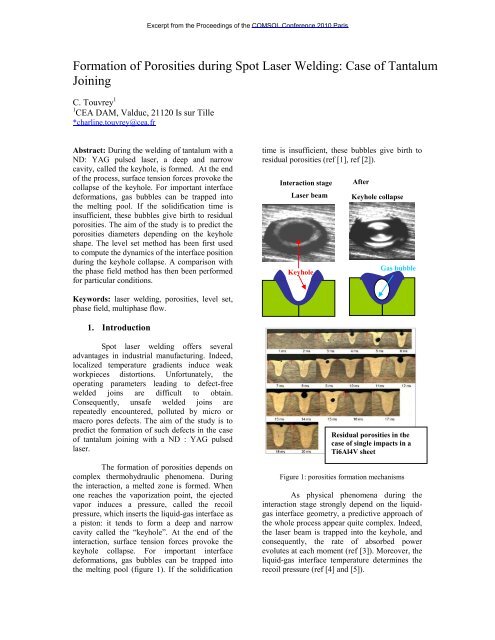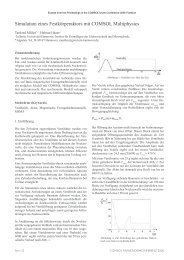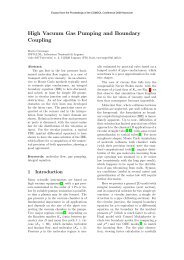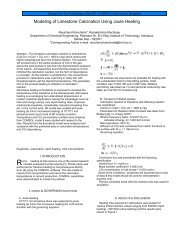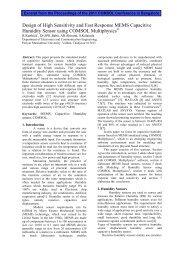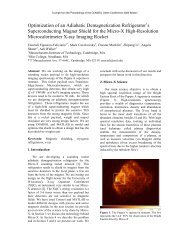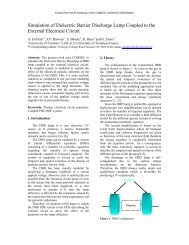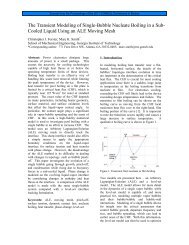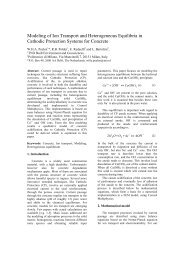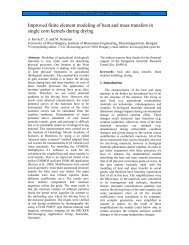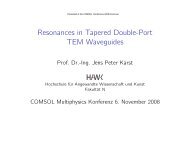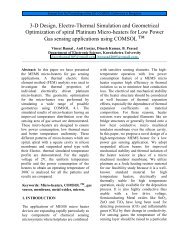Download Paper - COMSOL.com
Download Paper - COMSOL.com
Download Paper - COMSOL.com
You also want an ePaper? Increase the reach of your titles
YUMPU automatically turns print PDFs into web optimized ePapers that Google loves.
Formation of Porosities during Spot Laser Welding: Case of Tantalum<br />
Joining<br />
C. Touvrey 1<br />
1 CEA DAM, Valduc, 21120 Is sur Tille<br />
*charline.touvrey@cea.fr<br />
Abstract: During the welding of tantalum with a<br />
ND: YAG pulsed laser, a deep and narrow<br />
cavity, called the keyhole, is formed. At the end<br />
of the process, surface tension forces provoke the<br />
collapse of the keyhole. For important interface<br />
deformations, gas bubbles can be trapped into<br />
the melting pool. If the solidification time is<br />
insufficient, these bubbles give birth to residual<br />
porosities. The aim of the study is to predict the<br />
porosities diameters depending on the keyhole<br />
shape. The level set method has been first used<br />
to <strong>com</strong>pute the dynamics of the interface position<br />
during the keyhole collapse. A <strong>com</strong>parison with<br />
the phase field method has then been performed<br />
for particular conditions.<br />
Keywords: laser welding, porosities, level set,<br />
phase field, multiphase flow.<br />
1. Introduction<br />
Excerpt from the Proceedings of the <strong>COMSOL</strong> Conference 2010 Paris<br />
Spot laser welding offers several<br />
advantages in industrial manufacturing. Indeed,<br />
localized temperature gradients induce weak<br />
workpieces distortions. Unfortunately, the<br />
operating parameters leading to defect-free<br />
welded joins are difficult to obtain.<br />
Consequently, unsafe welded joins are<br />
repeatedly encountered, polluted by micro or<br />
macro pores defects. The aim of the study is to<br />
predict the formation of such defects in the case<br />
of tantalum joining with a ND : YAG pulsed<br />
laser.<br />
The formation of porosities depends on<br />
<strong>com</strong>plex thermohydraulic phenomena. During<br />
the interaction, a melted zone is formed. When<br />
one reaches the vaporization point, the ejected<br />
vapor induces a pressure, called the recoil<br />
pressure, which inserts the liquid-gas interface as<br />
a piston: it tends to form a deep and narrow<br />
cavity called the “keyhole”. At the end of the<br />
interaction, surface tension forces provoke the<br />
keyhole collapse. For important interface<br />
deformations, gas bubbles can be trapped into<br />
the melting pool (figure 1). If the solidification<br />
time is insufficient, these bubbles give birth to<br />
residual porosities (ref [1], ref [2]).<br />
Interaction stage<br />
Laser beam<br />
Keyhole<br />
After<br />
interaction:<br />
Keyhole collapse<br />
Gas bubble<br />
Residual porosities in the<br />
case of single impacts in a<br />
Ti6Al4V sheet<br />
Figure 1: porosities formation mechanisms<br />
As physical phenomena during the<br />
interaction stage strongly depend on the liquidgas<br />
interface geometry, a predictive approach of<br />
the whole process appear quite <strong>com</strong>plex. Indeed,<br />
the laser beam is trapped into the keyhole, and<br />
consequently, the rate of absorbed power<br />
evolutes at each moment (ref [3]). Moreover, the<br />
liquid-gas interface temperature determines the<br />
recoil pressure (ref [4] and [5]).
That’s why, for our problem, we have<br />
focused our attention on the cooling stage. The<br />
mechanisms of keyhole collapse have been<br />
apprehended thanks to a hydraulic model.<br />
Following a parametric analysis, we are trying to<br />
find a depth limit, from which gas bubble are<br />
always trapped. The following model have been<br />
originally developed by K. Girard and J. Nadal<br />
(ref [6]) in the software FLUENT. Unfortunately<br />
many numerical problems have been<br />
encountered by the authors, especially induced<br />
by interface instabilities.<br />
2. Physical model<br />
2.1 Shape of the keyhole at the end of the<br />
interaction<br />
As we only model the cooling stage,<br />
the geometry ok the keyhole at the end of the<br />
interaction must be determined.<br />
First of all, the position of the fusion<br />
isotherm is deduced from a metallurgical<br />
analysis, as shown on figure 2. Moreover, the<br />
keyhole’s ray, and the volume of metal<br />
accumulated at the surface, is measured<br />
according to visualizations of the melting pool<br />
with a high speed camera (figure 3). At last, K.<br />
Girad (ref [6]) proposes a good approximation of<br />
the liquid film dimension at the bottom of the<br />
keyhole (about 40 µm in our case).<br />
0,38 mm<br />
Figure 2: metallurgical analysis<br />
Figure 3: visualization of the keyhole<br />
In the model, we admit that the shape of<br />
the keyhole is ½ elliptic and that the metal<br />
accumulated at the surface tends to form a tore.<br />
By writing that the volume of the ½ tore is equal<br />
to the ½ ellipse’ one, we are able to deduce all<br />
the problem dimensions.<br />
2.2 Materials properties<br />
In the case of liquid tantalum, the density ρ is<br />
equal to 15630 kg/m 3 and the dynamic viscosity<br />
μ is equal to 8.032e -3 Pa·s. The surface tension<br />
coefficient is taken equal to 2.168 N.m -1 .<br />
1.2 Hypothesis<br />
The surface tension coefficient is supposed<br />
constant during the collapse stage. Characteristic<br />
dimensionless numbers calculation shows that:<br />
- the flow is laminar;<br />
- capillary effects are important<br />
-<br />
<strong>com</strong>pared to viscous ones:<br />
V<br />
3<br />
Ca 2.<br />
10<br />
ts<br />
gravity effect can be neglected:<br />
g.<br />
L²<br />
<br />
Bo 8.<br />
10<br />
ts<br />
3. Governing Equations<br />
The level set method has been first used<br />
to determine the evolution of the interface<br />
position. A <strong>com</strong>parison with the phase field<br />
method has then been performed for particular<br />
conditions.<br />
The Level Set application mode is<br />
largely described in ref [7]. The method enables<br />
to find the fluid interface by tracing the isolevel<br />
of the level set function, Φ. The isocontour Φ<br />
=0.5 determines the position of the interface. The<br />
equation governing the transport of Φ is:<br />
where u (m/s) is the fluid velocity, and γ<br />
(m/s) and ε (m) are numerical stabilization<br />
parameters. The ε parameter determines the<br />
thickness of the layer around the interface where<br />
4
Φ goes from zero to one. ε is generally taken<br />
equal to hc/2, where hc is the characteristic mesh<br />
size in the region passed by the interface..<br />
Generally, a suitable value for γ is the maximum<br />
velocity magnitude occurring in the model.<br />
In the Phase Field application mode<br />
(largely described in ref [7]), the two-phase flow<br />
dynamics is described by the Cahn-Hilliard<br />
equation. The method consists in tracking a<br />
diffuse interface separating the immiscible<br />
phases (region where the dimensionless phase<br />
field variable Φ goes from −1 to 1). The Cahn-<br />
Hilliard equation is solved in two times:<br />
where u is the fluid velocity (m/s), γ is<br />
the mobility (m3·s/kg), λ is the mixing energy<br />
density (N), and ε (m) is the interface thickness<br />
parameter. The mixing energy density and the<br />
interface thickness are related to the surface<br />
tension coefficient through the relation (réf 8):<br />
ε is usually set to half the characteristic<br />
mesh size in the region passed by the interface.<br />
The mobility parameter γ determines the time<br />
scale of the Cahn-Hilliard diffusion and is<br />
generally taken equal to ε 2 .<br />
In both the two methods, the transport<br />
of mass and momentum is governed by the<br />
in<strong>com</strong>pressible Navier-Stokes equations,<br />
including surface tension:<br />
In the above equations, ρ (kg/m3) denotes the<br />
density, u the velocity (m/s), t the time (s), p the<br />
pressure (Pa), and η denotes the dynamic<br />
viscosity (Pa·s). The momentum equations<br />
contain gravity, ρg, and surface tension force<br />
<strong>com</strong>ponents, denoted by Fst. But, in our case,<br />
gravity is neglected.<br />
The surface tension force is<br />
implemented differently in the Level Set and<br />
Phase Field application modes (ref [7]). The<br />
Level Set application mode <strong>com</strong>putes the surface<br />
tension as:<br />
where ζ is the surface tension<br />
coefficient, I is the identity matrix, n is the<br />
interface unit normal, and δ is a Dirac function,<br />
nonzero only at the fluid interface. The interface<br />
normal is calculated from:<br />
The level set parameter Φ is also used to<br />
approximate the delta function by a smooth<br />
function defined by:<br />
In the Phase Field application mode, the<br />
diffuse interface representation implies that it is<br />
possible to <strong>com</strong>pute the surface tension by:<br />
where Φ is the phase field parameter,<br />
and G is the chemical potential (J/m3):<br />
4. Numerical Model<br />
4.1. Initial state<br />
The initial state is deduced from<br />
observations and hypothesis made in<br />
paragraph 2.1. The initial interface<br />
geometry is described in figure 4.
0,34 mm<br />
0,04 mm<br />
Figure 4: initial state<br />
4.1. Boundary settings:<br />
The boundary conditions are presented on figure<br />
5.<br />
Axial<br />
symmetry<br />
0,43 mm<br />
Air<br />
0,32 mm<br />
Liquid<br />
tantalum<br />
Figure 5: boundary settings<br />
0,14 mm<br />
Open boundary<br />
Wetted wall<br />
For the level set method, the wetting phenomena<br />
are determined by the contact angle and the slip<br />
length. The velocity <strong>com</strong>ponent normal to the<br />
wall is set to zero:<br />
One adds a frictional boundary force:<br />
β is called the slip length. The angle between the<br />
wall and the fluid interface, called the contact<br />
angle θ, is supposed constant equal to pi/2. By<br />
default, the slip length is equal to the mesh<br />
element size, h. We will see thereafter the<br />
consequences of this dependence.<br />
For the <strong>com</strong>parison between the level set and the<br />
phase field method, the condition “wetted wall”<br />
has been replaced by a “slip wall” condition.<br />
4.2. Meshing<br />
The mesh must be homogenous along the liquid<br />
– gas interface in order to initialize correctly the<br />
problem. In order to analyse the model spatial<br />
convergence, the mesh size has been<br />
progressively reduced. When the mesh is<br />
consequently refined, the air domain size must<br />
be extended to obtain a converged solution.<br />
4.4 Choice of level set parameters<br />
In the present model, the mesh size is inferior to<br />
1e-5. Consequently, the value of ε has been fixed<br />
to 5e -6 and γ is equal to 1. Indeed, thanks to<br />
experimental measure, the velocity of the fluid<br />
doesn’t exceed 1 m.s -1 .<br />
4.3. Transient initialization:<br />
Before starting the fluid flow calculation, the<br />
level set function must be initialized. The<br />
initialization time is fixed to 5ε/.<br />
5. Results and discussion<br />
Firstly, the numerical behaviour of the model has<br />
been tested for a high dynamic viscosity (8 Pa.s).<br />
This allows a better model convergence. Some<br />
results are presented on the figure 6.<br />
The filling of the keyhole can be divided into<br />
two stages: a “detachment stage”, illustrated on<br />
figure 6.c, and a “filling stage”, illustrated on<br />
figure 6.d.
Figure 6: numerical results: keyhole<br />
collapse<br />
a<br />
b<br />
c<br />
d<br />
The results are stable while reducing the<br />
mesh size from 1.3.10 -5 to 3.1.10 -6 . Nevertheless,<br />
the detachment stage length increases while<br />
refining the mesh (board 1). It can be explained<br />
by the dependence between the mesh size and<br />
the slip length. Consequently, the slip length will<br />
have to be determined by <strong>com</strong>parison with<br />
experimental data (figure 7).<br />
Minimum detachment Filling stage<br />
mesh size stage duration duration<br />
1.3e-5 5 10<br />
6.4e-6 6 11<br />
3.1e-6 7 13<br />
Board 1: spatial convergence<br />
Thanks to a parametric analysis, it is<br />
confirmed that the gravity has no influence. The<br />
flow is laminar, with a maximum velocity of 0.5<br />
m.s -1 . It asserts the good choice of = 1.<br />
The <strong>com</strong>plete filling time, about 20 ms, is<br />
longer than expected. Indeed, a high speed<br />
camera film shows that the keyhole collapse<br />
doesn’t exceed 1 ms (figure 7). This can be<br />
explained by the non physical value of the fluid<br />
viscosity.<br />
Figure 7: experimental results: keyhole collapse<br />
A <strong>com</strong>putation has then been performed with the<br />
phase field method. Neglecting the wetting<br />
phenomena, it confirms the interface shape
obtained by the level set application mode. The<br />
sliding condition between the solid and the fluid<br />
induces a collapse time of 8 ms in the two cases.<br />
Considering the real viscosity of the fluid<br />
(8.032e -3 Pa.s -1 ) makes the model convergence<br />
difficult to obtain. Indeed the liquid film<br />
undergoes a thinning (figure 8) and the mesh size<br />
must be consequently reduced to allow the<br />
convergence. The results are stable while<br />
refining the mesh. Nevertheless, the interface<br />
shape does not seem physically correct, and this<br />
part of the study will have to be reconsidered.<br />
Figure 8: interface shape with the real viscosity<br />
6. Conclusions<br />
In order to predict the risk of porosities<br />
formation during tantalum welding, a model has<br />
been developed to simulate the keyhole collapse.<br />
Two Eulerian methods have been used and<br />
<strong>com</strong>pared: the Level set and Phase Field<br />
methods.<br />
If the interface shape seems to be physically<br />
correct for a high fluid viscosity, the liquid film<br />
undergoes a thinning when considering the real<br />
tantalum viscosity (8.032e-3 Pa.s -1 ). This<br />
phenomenon has to be studied, especially by<br />
<strong>com</strong>paring different numerical methods.<br />
In order to evaluate the diameter of the<br />
pores that may affect our welded joints, we are<br />
currently working on a second model to simulate<br />
the bubbles up rise simultaneously with the<br />
solidification front progress (thermo-hydraulic<br />
approach).<br />
7. References<br />
1. Girard, K., Jouvard, J.M., Boquillon, J., Bouilly, P.,<br />
and Naudy, P., 2000, SPIE Conf. (Bellingham,<br />
SPIE), 3888, pp. 418-28.<br />
2. Kaplan, A., Mizutani, M., Katayama, S., and<br />
Matsunawa, A., 2002, Unbounded keyhole<br />
collapse and bubble formation during pulsed laser<br />
interaction with liquid zinc, J. Phys. D: Appl.<br />
Phys., 35, pp. 1218-1228.<br />
3. Medale, xhaard, guignard “A Thermo-Hydraulic<br />
study of a thin metal plate submitted to a single laser<br />
pulse”, Proceedings of 4th ICCHMT, May 17–20,<br />
2005, Paris-Cachan, FRANCE<br />
[4] W. Semak, W.D. Bragg, B. Damkroger, S.<br />
Kempkas, Temporal evolution of the temperature<br />
field in the beam interaction zone during lasermaterial<br />
processing, J. Phys. D: Appl. Phys. 32<br />
(1999) 1819-1825.<br />
[5] P. Solana, P. Kapadia, J.M. Dowden, P.J.<br />
Marsden, An analytical model for laser drilling of<br />
metals with absorption within the vapour, J. Phys.<br />
D: Appl. Phys. 32 (1999) 942-952.<br />
[6] Karen Girard, “étude de la formation des porosités<br />
dans les soudures de tantale par laser ND:YAG<br />
impulsionel”, thèse, 1999<br />
[7] Bubble rising, <strong>COMSOL</strong> documentation<br />
[8] P. Yue, J. Feng, C. Liu, and J. Shen, “A Diffuse-<br />
Interface Method for Simulating Two-Phase Flows of<br />
Complex Fluids,” J. Fluid Mech., vol. 515, pp. 293–<br />
317, 2004.<br />
[9] C. Touvrey, “étude thermohydraulique du soudage<br />
impulsionnel de l’alliage TA6V ” thèse, 2006<br />
8. Acknowledgements<br />
Thanks to JM. Petit, from <strong>COMSOL</strong> <strong>com</strong>pany,<br />
who has developed the original model of<br />
keyhole’s collapse in the case of high fluid<br />
viscosity.<br />
Thanks to R Fabbro and K Hirano, from ARTS,<br />
who have realized the visualization of the<br />
melting pool with a high speed camera.


